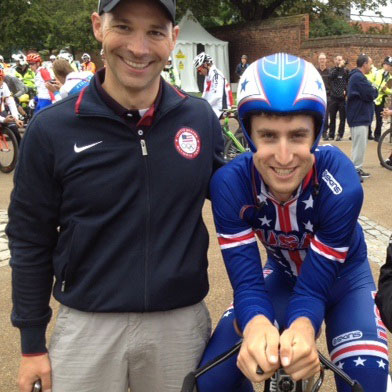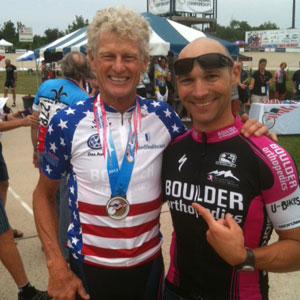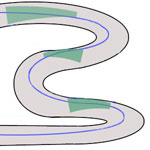Bike handling

If you talk to experienced cyclists, triathletes aren’t particularly known for being good bike handlers. Whether or not that reputation is deserved is up to question, as there are many triathletes who are very good bike handlers. But, the Internet (and even these forums) abound with both humorous and harrowing tales and footage of triathlete bike mishaps. And don’t even get a pure road cyclist started on the topic.
To be fair, outside of draft legal racing, the nature of the sport doesn’t inherently lend itself to skills development. Most age groupers participate in non-draft legal races; triathlon bike courses don’t typically demand as high a level of technical skill as crits or circuit races; and many triathletes train alone, thus rarely having the opportunity to develop group riding skills.
But bike handling matters for a triathlete. First, the obvious: better bike handling will improve your cycling segment and your transitions. Beyond that, it enables you to be safer on the bike, where you spend the most time among the three disciplines. It will make you more confident in both training and racing. And it will enable you to train with others and derive the benefits of group training.
So, what are the bike skills a triathlete should be concerned with? How can a triathlete develop those skills? And how can you fit skill-building into your training schedule?
To help answer these questions, I turned to coach Neal Henderson, whose Boulder-based group of athletes includes strong bikers Flora Duffy, Joe Gambles and Cameron Dye, as well as cycling phenoms Taylor Phinney and Evelyn Stevens. At the 2012 London Olympics, Henderson had four athletes (Duffy, Phinney, Stevens and road cyclist Roman Kreuziger) as well as the USA women’s track cycling team under his watch. Not surprisingly, he is a longtime, vocal proponent of triathletes becoming better cyclists. (Images here are of Neal with some of his charges.)
Balance
The most basic bike skill is balance. Eating and drinking on the bike, holding a line while riding, and looking behind the bike without swerving are all balance skills.
To develop balance on the bike, “a really, really great tool that is underutilized is the rollers,” says Henderson. He has his athletes ride the rollers at a slow cadence as well as fast, as it’s much more difficult to keep your balance on rollers when you’re going slow. As you get better on rollers, you can gradually develop the ability to do tasks including transitioning between aero bars to base bars or drops, or eating and drinking.
Henderson also runs a simple balance drill at his training camps. He gets a group of riders together on the grass, and stakes out a large square with a set of four cones. Riders stay in their easiest gear and simply have to move around one another and remain upright within the square. As riders get more proficient, the square becomes smaller and smaller. This “square drill” develops balance, bike control, and comfort riding in close proximity of others.
Cornering
The inability to take corners at speed can be dangerous, as well as cost valuable energy and time in a race as the rider slows down excessively and then cranks hard to get back up to speed over and over again.
Henderson rattled off a list of considerations that should be taken in a corner. “Where you’re holding on the handlebars: are you in the drops or are you on the hoods? Distribution of your weight. Countersteering, or not. Always bringing the inside pedal up in a corner, driving the weight through the outside leg, almost pushing so hard that your butt is almost a little bit off the saddle. Where you’re looking as you’re going through the turn. Judging your speed before you enter your turn and making an adjustment before you start turning the bike. Braking in a turn is incredibly dangerous.”

“Once you commit into a turn…you’re in it. You can change your direction a little bit, but not a lot. So, think about how you set up for a corner. Not pedaling too soon out of a corner. Shifting ahead of time so that as you exit the turn you’re in an appropriate gear. Being able to lean the bike and body appropriately.”
All these are components to good cornering. During his skills sessions, Henderson moves on to a series of cornering drills in a parking lot after the “square drill” in the grass. First, riders will do a basic one-corner drill by riding a simple oval, marked by two cones. They’ll move in one direction first, then switch to the other. After the oval drill, Henderson sets up a slalom course with a row of cones. Riders weave through the cones, progressively faster and faster. Henderson captures it all on video to make observations about form and technique. (If you’re doing these on your own, he suggests setting up an iPad to record your own footage).
The effect of good or bad cornering is amplified on the downhill. “If you can’t corner properly on a flat road, you’re not going to corner properly on a descent. So first things first. Be able to do it on flat ground in both directions, not just acceptably, but well. [If you don’t have that down], you’re going to have trouble when you start going down a steeper mountain.”
For more on descending as well as cornering, read this excellent, older piece by Dan Empfield that goes further in-depth on when to brake, how to pick a line, and the impact of bike position on cornering and descending.
Neuromuscular Coordination
While neuromuscular ability is not a bike “handling” skill per se; it is also a key cycling skill that can be practiced and drilled just like handling ability.
“Most athletes have a lack of cadence range,” says Henderson. “If you can’t pedal more than 120 rpm your range is pretty poor. 150 is still kind of, eh.” (He noted, however, that cadence is affected by your bike position and crank length). To work on neuromuscular ability, Henderson prescribes single-leg drills and cadence builds for his athletes. His cadence builds involve starting at a normal cadence of about 80-90 rpm, and progressively doing efforts ranging from 20-60 seconds, increasing cadence to the absolute maximum. You’re not concerned with power output on these, just leg speed. When Henderson runs Dye, Gambles, and Duffy through these drills they will hit anywhere from 160 rpm to 200 rpm.

Having a wide cadence range gives an athlete the ability to tolerate and recover from various stressors over a long course. “If you have no ability to increase your cadence, when you have a downhill section and a tailwind, and you can’t pedal at all versus somebody who can pedal a little, then that athlete will go faster than you. And it doesn’t have to be a super high output, it’s just that little bit of work…If you don’t have any leg speed, your ‘ceiling’ is lower. So if what you’re sustaining is so close to your ceiling, you’re not as efficient as that athlete who has a bigger ceiling and can hold 110 rpm comfortably for a while. If their ceiling is 160 rpm or 180 rpm, going to 110 or 120 rpm for 10 to 30 seconds is not as much of a neuromuscular stress.”
Leg speed is also the basis of sprinting ability. While most triathletes focus primarily on longer, steady efforts at or near race pace, the need to perform higher-end efforts that recruit neuromuscular coordination will crop up during a race as you accelerate out of corners, go up short, punchy hills, or surge to pass competitors within the time limit. “These efforts require you to either gear down, slow down and lose speed; or apply a little bit of quick, high-force, high-power effort for short duration — a sprint-type effort. It doesn’t have to be maximal, just one to get your speed back up. If you’ve never done that in training, you’ll have trouble in the race,” says Henderson.
Pack Riding
Of all the skills a triathlete could have, however, one reigns king in Henderson’s eyes. His definition of a good bike handler, in the context of triathlon, is an athlete who can ride with others.
Why are pack riding skills so important for an athlete who only races non-drafting events? For one, pack riding requires you to embody all of the above skills (hold a line, take corners, descend, etc.), but to do so within tight quarters. Being able to ride with a group allows you to train with others, which is more enjoyable and often makes you push harder than you would on your own. And finally, there are just certain situations, such as training camps, in which group riding is unavoidable. “If you don’t have the requisite skills in those situations,” Henderson shrugs, “you won’t have as good of an experience.”
Pack riding skill starts with what’s between the ears. You should know the etiquette, including the responsibility to point out hazards, communicate, take your pull, and more. Equipment can be part of this. Some group rides don’t allow TT bikes, for example, and “showing up with your deep-dish wheels…is generally frowned upon,” says Henderson. Enumerating the rules of group riding etiquette is a whole other article, but in general when you ride in a group, Henderson says, you should be smooth and predictable.
“When you come to the front to take a pull, realize that your speed impacts the rest of the group on an increasing basis as it moves down the line. So if the person on the front punches it, then there is an amplified response behind — you get this ‘slinky’ effect, and as it goes back it becomes more difficult for people to ride with that group. That’s not the idea, that when you go to the front you make this big, monstrous effort. When you come to the front and you change the speed that a group is a moving at, you need to meter out the effort over the entire duration of the pull.” You should also ride in a smooth, straight line and be proactive in communicating your next move. In a group riding situation, “communication is key and your actions impact others. And that impact can be significantly negative if the way you ride is dangerous.”
Finally, you should have a knowledge of group dynamics and how they change according to the conditions. “You should understand how a paceline, double paceline, rotating echelon and echelon work. If you have no idea what those are, you’re not going to be successful in a group ride,” says Henderson.
Fitting Skills into Training
Working on bike skills doesn’t have to be a huge production, and you can work skills sessions into your existing training plan.
While there are a lot of parking lot drills you could look up on the Internet, Henderson advises athletes to keep it simple so that the practice actually gets done. He recommends the three very basic drills described above for balance and cornering (square drill on grass, single-corner oval drill, and slalom course). “Generally speaking, 30 to 60 minutes is completely adequate time for a skills drills session. Do those on what would be an easy bike day, set up some cones, and make it the focus of the day,” says Henderson. Invest in a set of rollers for some of your indoor sessions—you can do your cadence builds or single-leg drills on rollers as well.
How often you do skills days will depend on your cycling ability, but Henderson would schedule skills for some athletes as often as once a week until they’re proficient. After that, he’ll put them into a maintenance mode of about once every two or more weeks, unless they are riding in a group regularly.
Most importantly, train with a group on a regular basis—at least once a week, says Henderson. “Even more so than drills, the biggest thing for improving handling is riding with others. It helps you develop faster than anything else. Some people think a group ride always has to be some big, hard, high-intensity thing. No. You could go out and do pacelines with four or five other folks on an easier ride, and still be getting something out of it.” His elite athletes train together in groups once to twice a week, practicing pacelines, echelons, and even leadouts. Some of his athletes will also participate occasionally in bike races to work on pack riding skills.
He encourages athletes to learn from more experienced riders or pure cyclists, and to find an appropriate group to learn from. “Look to the local cycling teams for what’s out there. Talk to the folks at the bike shop and ask them what the group ride is like. They might say, ‘This ride is pretty much like a race’, or there may be rides that are more open to beginners and more instructional.”
Henderson acknowledges that for some athletes, setting out cones in a parking lot or re-learning how to pack ride can feel like taking a step back. But as with everything else in the sport, becoming a better bike handler “takes time and effort. Time doing things and conscious effort while doing them. You have to put energy into it to get anything out of it…You don’t develop skills because you hope you have them. You put it into practice.”


